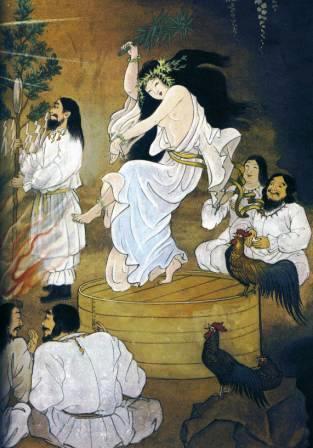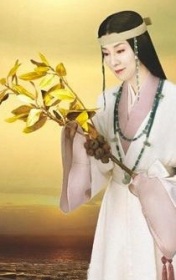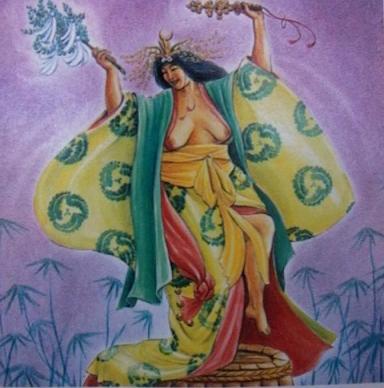 “Ame no Uzume ‘s themes are honor, longevity, wisdom, psychic abilities, prosperity, protection and kinship. Her symbols are antique items, aged wines or cheese (anything that grows better over time) and sacred dances. A Japanese ancestral Goddess, Ame no Uzume’s magic is that of generating a long, happy life for Her followers. Shinto festivals in Her honor include special dances that invoke the Goddess’s favor for longevity, honor, prosperity, protection and a close-knit family. In some areas, people also turn to Her for foresight, considering Ame no Uzume the patroness of psychic mediums.
“Ame no Uzume ‘s themes are honor, longevity, wisdom, psychic abilities, prosperity, protection and kinship. Her symbols are antique items, aged wines or cheese (anything that grows better over time) and sacred dances. A Japanese ancestral Goddess, Ame no Uzume’s magic is that of generating a long, happy life for Her followers. Shinto festivals in Her honor include special dances that invoke the Goddess’s favor for longevity, honor, prosperity, protection and a close-knit family. In some areas, people also turn to Her for foresight, considering Ame no Uzume the patroness of psychic mediums.
Join with people in Japan and celebrate the wisdom that longevity brings for the aged. If there is an elder in your family or magic community who has influenced your life positively, pray to Ame no Uzume for that person’s ongoing health and protection. Go see that individual and say thank you. The gesture greatly pleases this Goddess, who will shower blessings on you, too!
To gain Ame no Uzume’s insight in your psychic efforts, find an antique item that you can wear during readings, like a skeleton key (to ‘fit’ any psychic doorway). Empower this token, saying:
‘Ame no Uzume, open my eyes, help me to see!
Let nothing be hidden that need to be known, whene’re I speak this magical poem.’
Touch the key and recite your power phrase, the incantation, before reading.”
(Patricia Telesco, “365 Goddess: a daily guide to the magic and inspiration of the goddess”.)
“Ame-no-Uzume-no-mikoto is the Goddess of dawn, mirth and revelry in the Shinto religion of Japan, and the wife of fellow-god Sarutahiko Ōkami“. [1]
Patricia Monaghan writes that Uzame was “ancient Japan’s shaman Goddess…who lured the sun Goddess Amaterasu from the cave where She’d hidden. She did so by a merry mockery of shamanic ritual. Tying Her sleeves above Her elbows with moss cords and fastening bells around Her wrists, She danced on an overturned tub before the heavenly Sky-Rock-Cave. Tapping out a rhythm with Her feet, She exposed Her breasts and then Her genitals in the direction of the sun. So comic did She make this striptease that the myriad gods and Goddesses began to clap and laugh – an uproar that finally brought the curious sun back to warm the earth.
 Shaman women who followed Uzume were called miko in ancient Japan. First queens like Himiko, later they were princesses and even later, common-born women. Some Japanese women today, especially those called noro and yuta in Okinawa and the surrounding islands, still practice shamanic divination” (p. 305).
Shaman women who followed Uzume were called miko in ancient Japan. First queens like Himiko, later they were princesses and even later, common-born women. Some Japanese women today, especially those called noro and yuta in Okinawa and the surrounding islands, still practice shamanic divination” (p. 305).
“Ame-no-Uzume-no-Mikoto is still worshiped today as a Shinto kami, spirits indigenous to Japan. She is also known as Ame-no-Uzume-no-Mikoto, The Great Persuader, and The Heavenly Alarming Female. She is depicted in kyōgen farce as Okame, a woman who revels in her sensuality.” [2]
“The dances of Uzume (Ama-no-uzume) are found in folk rites, such as the one to wake the dead, the Kagura (dance-mime), and another one which symbolizes the planting of seeds.” [3]
Sources:
Lindemans, Micha F. Pantheon.org, “Uzume“.
Monaghan, Patricia. The New Book of Goddesses and Heroines, “Uzume”.
Wikipedia, “Ame-no-Uzume-no-Mikoto“.
Suggested Links:
Agaliha. Mysticwicks.com, “Ama-no-Uzume“.
Ampontan. Ampontan.wordpress.com, “Yuta: The Japanese Shamans“.
Ashkenazi, Michael. Handbook of Japanese Mythology.
Corrao, Tom. Chicagookinawakenjinkai.blogspot.com, “Okinawan Uta – The Shaman Women of Okinawa“.
Goddessgift.com, “Amaterasu Goddess of the Sun/Uzume Goddess of Mirth and Dance“.
Lysianassa. Bukisa.com, “The Goddess Ame No Uzume in Mythology and History“.
Mydailygoddess.blogspot.com, “Uzume – Laughter“.
Schoenberger, Karl. Latimes.com, “Shamans Look to Spirits for Guidance: In Okinawa, Supernatural Is Taken Very Seriously“.
Wikipedia, “Ryukyuan Religion“.
Willis, Roy G. World Mythology, “The Divine Crisis“.











3 Trackbacks / Pingbacks for this entry:
[…] shaman Uzume, Goddess of merriment, finally took matters into Her hands. She turned over a washtub, climbed on […]
[…] one of his blog entries, Kurt Bell explains: “Okame, also known as Uzume or Otafuku is the name for the female half of a traditional Japanese Kyogen theatre pair. She is […]
[…] 2. Ame No Uzume: The striptease that brought back the sun […]